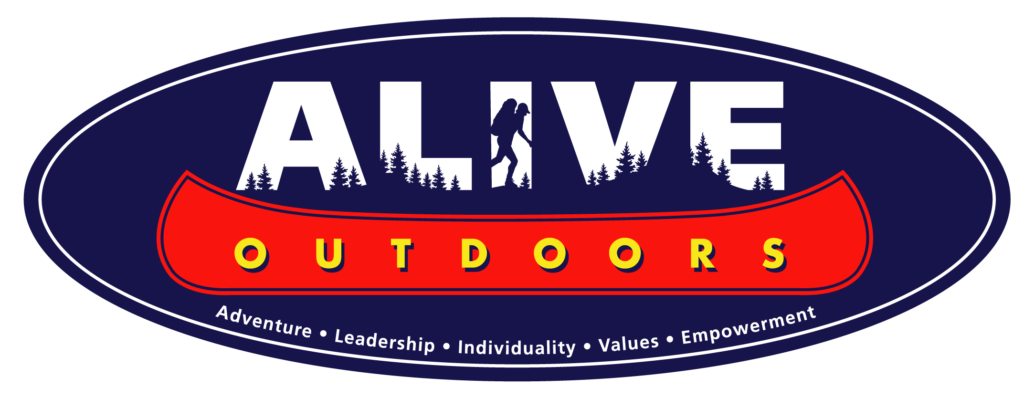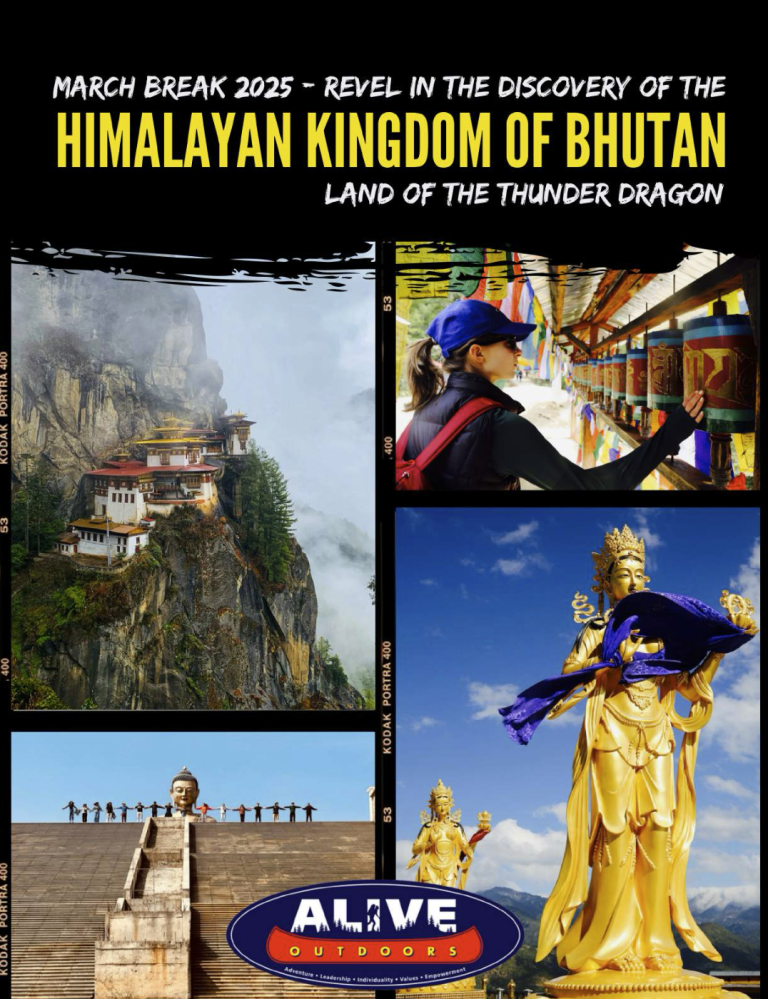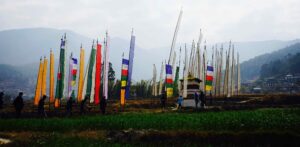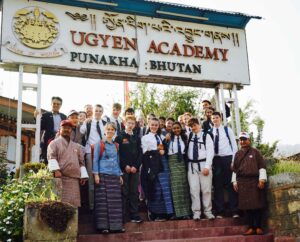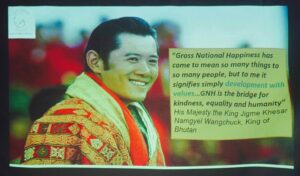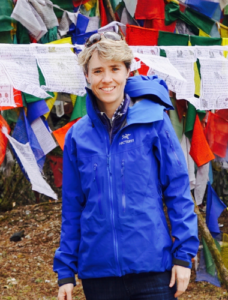The Kingdom of Bhutan
March Break 2025
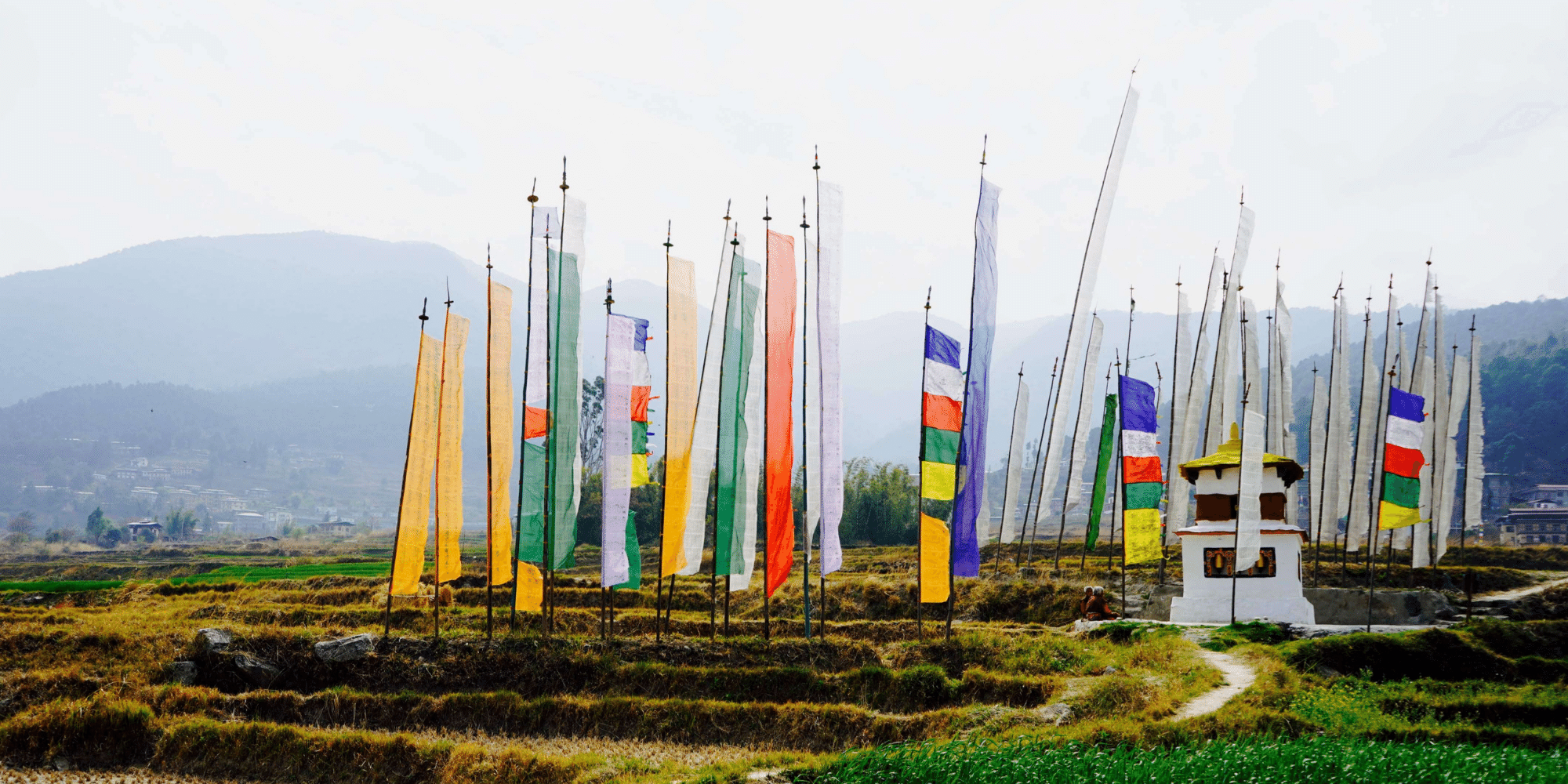
Image Slide 2
Image Slide 1
We travel not to escape life, but for life not to escape us.
Image Slide 3
The real voyage of discovery consists not in seeking new lands but seeing with new eyes.
March Break 2025 Brochure
A place unlike anywhere else on earth!
There is a place tucked away in the Himalayas that not many people have had the opportunity to visit called the Kingdom of Bhutan. Over the past nine years, we have had the privilege of spending time in Bhutan with student groups and will be back again in March 2025. We have helped facilitate student experiences in Bhutan in 2017 (one group/two schools), 2019 (one group/two schools), 2023 (2 groups/four schools), one adult group in 2023, and one school group in 2024. There are several reasons why we continue to return to Bhutan. Still, the main driving force is because we believe that Bhutan’s palpable, calm energy, coupled with its stunning Himalayan landscape, its spiritual teachings and low-volume approach to tourism makes it the ideal location for us to share an incredible journey where all participants can not only reground and connect with themselves, but also learn many important life lessons that will help guide them throughout their lives.
Video Highlights From Our 2017 Trip
The Kingdom of Bhutan
Explore Past Student Experiences from our Student Learning Blogs
Reimagining Success
The Kingdom of Bhutan is a country all about happiness. This differs so much from most other countries in the world. Back in Canada, I never learned to prioritize happiness.
Incredible Kindness @ Ugyen Academy
Beaming faces greeted us as we walked into the grade nine Dzonka class at Ugyen Academy. These new faces would soon become close friends over the duration of the day.
Opening To A New Way of Living
Heading into this trip, I didn’t know what to expect. In all of the presentations and meetings leading up to our departure, the bar was set really high; yet I
EXPLORE OuR 2023 & 2024 TRIP Pages
March 2023
Royal St. George's College & St. Mildred's-Lightbourn School
Learn more about the 2023 experience.
March 2023
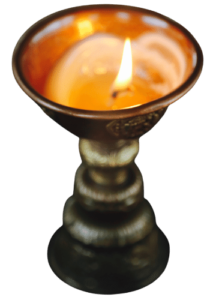
We love bringing students and staff together from different schools.
It allows for a dynamic experience where new friendships can be forged, shared learning can occur and meaningful memories can create deeply rooted connections. Students and teachers join the journey to this small Buddhist country where monasteries and dzongs (fortresses) spot the forest, where the mountainous landscape is stunning, and where the local people have a generosity of spirit that is sincerely genuine. Participants (students and teachers) travel in groups no larger than eighteen alongside an ALIVE instructor, Bhutanese guides and a dedicated professional bus driver from our partner organization Good Karma Travel.
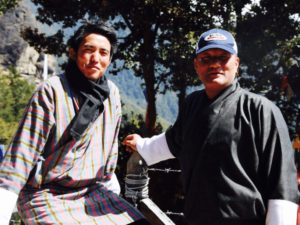
Our Incredible Bhutanese Guides
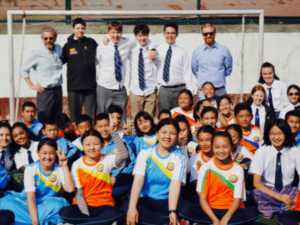
Connection with Local School Partners
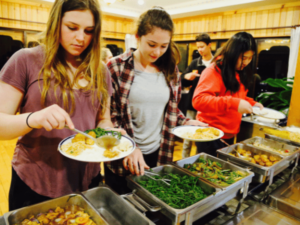
Tasty Local Meals With Lots of Options
The Kingdom of Bhutan Global Learning Itinerary and Details
Key Highlights
Every trip will have their own itinerary, however there will be some similarities to each experience.
- Dochula Pass, a collection of 108 chortens and prayer flags.
- Memorial Chorten – The Memorial Stupa, also known as the Thimphu Chorten, is a stupa, popularly known as “the most visible religious landmark in Bhutan.”
- Centenary Park and Buddha Point, where a massive statue of Shakyamuni measures in at a height of 51.5 meters, making it one of the largest statues of Buddha in the world. As well, groups have the opportunity to travel inside Buddha, where 125,000 smaller Buddhas reside.
- Punakha Dzong – Punakha Dzong is built on the confluence of the Two rivers Pho chu and Mo chu. It is a magnificent structure and a marvel of traditional Bhutanese architecture. It is considered a pride for Bhutan.
- Hike to Taktsang Monastery (Tiger’s Nest), approximately 1000 meters above the Paro valley. The oldest temple founded in 7th century by Tibetan king Songsang Gangpo.
- Learning exchange with students from a local school, overnight, sharing insights with each other about happiness, health, success and personal values.
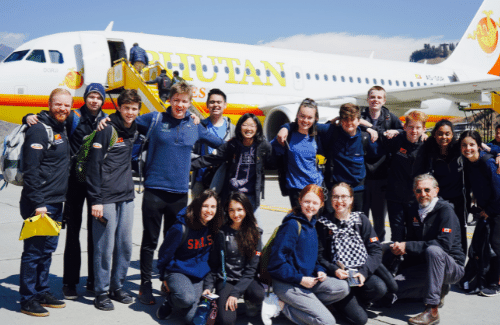
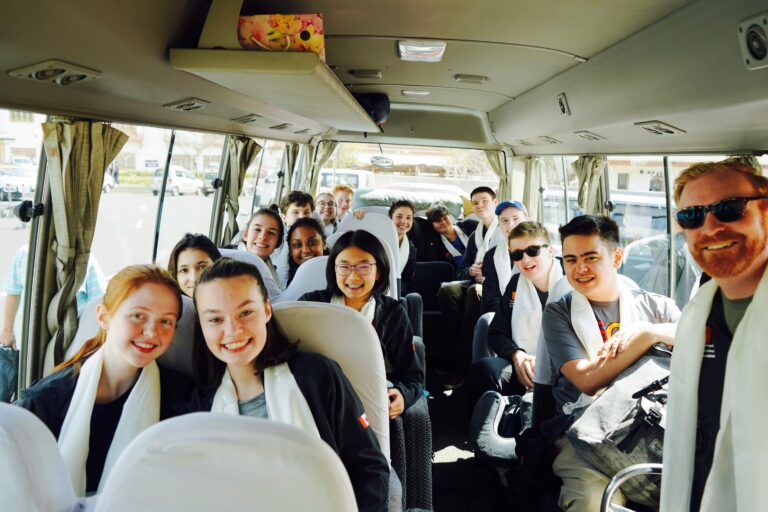
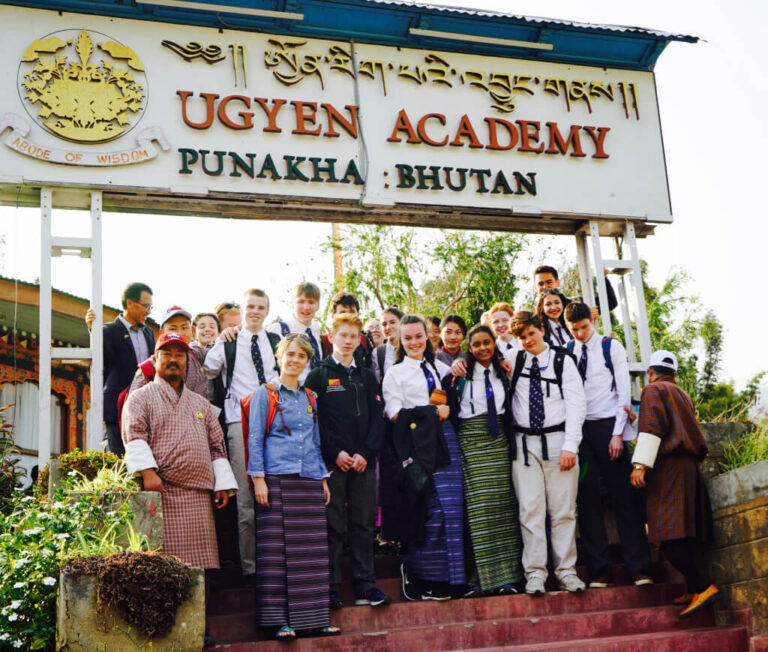
Dochula Pass
Memorial Chorten
Centenary Park and Buddha Point
Punakha Dzong
Taktsang Monastery (Tiger's Nest)
Learning Exchange
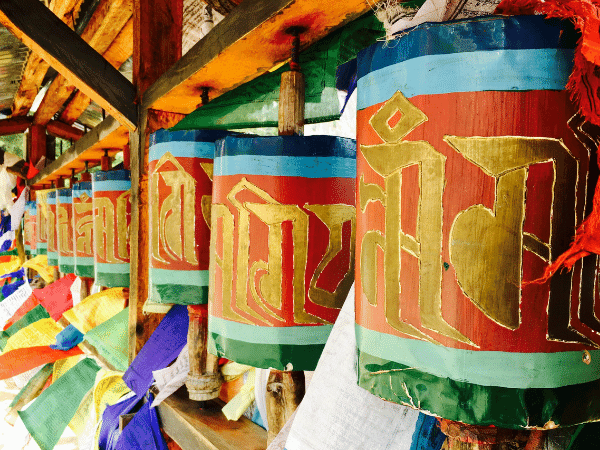
Bhutan Trip Objectives
- To evaluate and examine our own perspectives and our personal values.
- To learn from and share with some of Bhutan’s Secondary School students. Everyone has a different idea of what happiness and success looks like. This will be an opportunity to exchange ideas and examine personal values from very different perspectives.
- To deepen and expand our worldview.
- To be immersed in a society that will contrast the difference in pace and values between a life centered in Western consumerism versus intentional and unhurried living.
- To appreciate Buddhist cultural traditions and spirituality, as well as environmentalism and commitment to conservation.
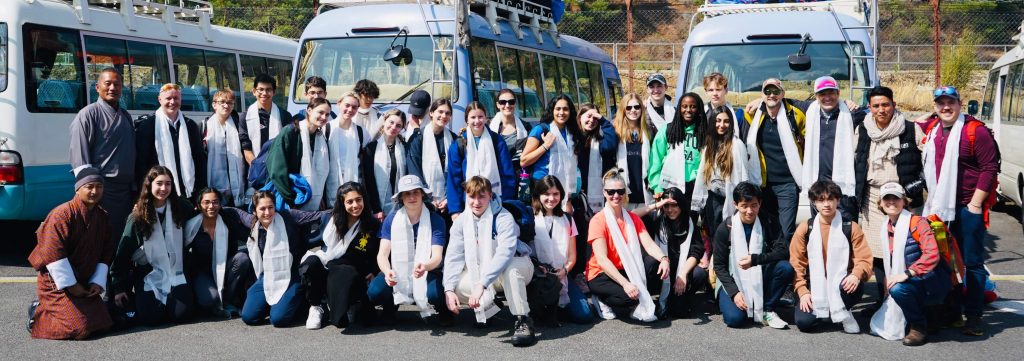
The Finer Details
The trip is typically 8-9 days in length in Bhutan, but when you add in travel time and a potential first or last day in Bangkok, Thailand you are looking at about 11-12 days of time away from home. Most trips are taken during March Break, but we are open to other times of the year.
Our intention is for students from each school to stay together with their chaperone, however, if numbers warrant it, and there is a desire to be mixed with other schools we are totally open to that, as long as there is a chaperone with each student group. Bus groups are limited to 18 participants (students and teachers). If one school has 18 students interested, and they wish to have their own bus and their own itinerary that is doable as well. Typically, trips end up having smaller groups from a few schools that are together in one bus.
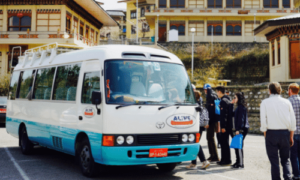
While in Bhutan participants travel on a bus that is dedicated to their group, with a dedicated driver who holds their Tourist Vehicle Drivers License. They will be with us for the duration of our trip.
Hotels
All rooms are based on double occupancy. If numbers warrant it based on group numbers, a 3rd person may be added to a room. Hotels will be booked once the group is established, and the itinerary is finalized.
School Boarding Stay
One night will be spent on a student exchange where participants will sleep at our partner exchange school to share an experience with Bhutanese students. The Boarding School Dorm Supervisor will oversee the students for this evening. Chaperones will be in a nearby hotel and reachable by cell phone at all hours. We will spend the day at the school prior to their overnight experience and will meet the Supervisors that day.
Camping in Bhutan (Glamping)
Depending on the trip’s itinerary, groups may spend one night at a riverside scenic campground. Tents will be shared by two people (mattresses and sheets provided). Chaperones will be placed in their own tents in the same tent line as the students. The campground is equipped with washrooms that have western-style toilets, outdoor showers with running hot water, an outdoor dining gazebo, and a gathering area with benches and a fire pit.
Wi-Fi in Bhutan can be spotty and slower than at home, but it’s still quite accessible. Most hotels have it in their lobby. Some will have it available in the rooms, and some will not. Of course staying connected is important. We will be posting photos and student blogs throughout the trip for friends and family to follow along. It’s very easy to purchase an affordable SIM data card in Bhutan and have service there, or to add on a phone plan from your provider before leaving Canada. The biggest hurdle to staying in is the time difference.
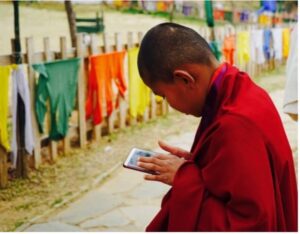
Bhutan is 10 hours ahead of our Eastern Standard Time. Flipping our body’s clock is not easy. We will work together as a group before our departure to learn some prevention tips for jet lag and how to set ourselves up for success. Typically trips will return approximately five days before the end of March Break to allow participants to rest and reground before heading back to school.
Bhutan is the world’s last surviving Himalayan Buddhist kingdom and is one of the only countries to place humility and compassion at the centre of its constitution. The three main themes of Buddhism are detachment, ephemerality (the concept of things being transitory, existing only briefly) and change. Throughout this journey, there will be ample opportunity to learn from many local people of all ages about their spirituality and culture, and how it plays a significant role in how they live their lives. This in turn will allow for many reflective moments both personally and as a group.
Bhutan is among the world’s leading countries in clean energy. At the moment, Bhutan is the only carbon negative country in the world. As mandated in its constitution, Bhutan preserves (at all times) 60 percent of its land under forest cover. According to the decree of the King, cut one tree for whatever purpose, you must plant 3 new trees. Plastic bags are banned. These positive policies help Bhutan have a pristine environment and one of the most diverse ecosystems in the world. Part of the pre-departure work that we will do as a group is to work to find ways that we can work to off-set our inevitable carbon emissions.
To learn more about Bhutan’s commitment to our planet watch this inspiring TED talk. https://www.youtube.com/watch?v=7Lc_dlVrg5M
March is a good time to visit Bhutan. The valleys are beginning to warm up, flowers are starting to bloom and there are clear views of the Himalaya. Temperatures tend to vary based on altitude, but on average it’s about 10-22 degrees Celsius.
When groups land in Paro the altitude will be 2200m, groups then travel through Thimphu, altitude of 2334m, and eventually down into the Punakha region, altitude of 1242m. The highest we will go is towards the end of our journey when we visit Chelala Pass (highest mountain pass in Bhutan), altitude of 3988m (just over 13,000ft), and trek up to Taktsang Monastery (Tiger’s Nest) which sits at approximately 3120m (just over 10,000ft).
Yes. We are happy to work with individuals, couples, and small groups who would like us to plan a trip to Bhutan for them. We will create the itinerary, line everything up with our partners in Bhutan and have them meet you when you arrive in Paro. Let us know if we can help you explore the beautiful Kingdom of Bhutan.
Given the remoteness of this trip, these are the conditions that should be able to be met. Students should be able to comfortably be away from home for an extended period. Families should be aware that we will have limited access to immediate mental health resources and support. Participants should be able to adapt appropriately to unfamiliar living conditions such as eating different food, following different customs, and adjusting to a different time zone. As well they must have the ability to deal with potential conflicts in a small group environment and be flexible as our schedule may shift and change for several reasons, such as weather. From a fitness perspective students should be comfortable hiking at altitude for up to 4 hours at a time. They should also be comfortable moving every day, walking, rafting (floating), camping, etc.
The final per-person fee will be shared by each participating school. The school organizes the flights and travel insurance, which is partly dependent on the number of participants travelling and the timing of the flight purchase from Toronto to Thailand.
Included in the Program Fee:
- Flights between Bangkok and Paro
- Bhutan entry visa
- Bhutanese guide and ALIVE Outdoors facilitator with the group
- Sustainable Development Fee
- Hotel for eight nights in Bhutan, and one night in Bangkok, Thailand (if required due to flight timing)
- All meals in Bhutan (students must pay for their food/snacks while in transit at the airports)
- All fees required to enter the Dzongs/Monasteries, hikes, and other activity fees.
- All transportation between destinations in Bhutan with a dedicated professional bus driver and dedicated bus.
- Any transportation and programming in Thailand, if day-one allows for some programming.
Not included in fee:
- Travel vaccinations
- Meals and snacks at airports while in transit.
- Personal spending money for souvenirs.
- Tips for guides, bus drivers (the group will tip together at the end of the trip).
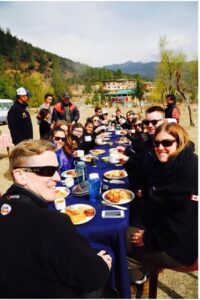
Since most travel in Bhutan is via an all-inclusive package, most of your meals will be in the form of a hotel buffet comprising continental, Indian, Chinese and a few less spicy Bhutanese dishes.
On longer drives or hikes, we will not return to our hotel for lunch. Most of the time there will be a roadside/riverside picnic. This is typically a hot lunch packed inside a series of metal containers packed inside a wide insulated flask. Our local partners set up tables and chairs at a scenic lookout for a meal to remember.
Please be sure to include all your dietary needs/allergies in detail on your ALIVE Medical form so we can inform our partners in Bhutan ahead of time.
All participants are highly encouraged to visit a travel doctor at least six weeks before their travels. As with all travel, various illnesses from exposure to different food, and changes due to interrupted sleep patterns can interrupt your trip and make you feel miserable. Some people may feel the effects of the altitude, but typically after the first few days, most people acclimatize to the altitudes that we will spend the majority of our time at. You will need to share your destinations with your travel doctor so they can make the best recommendations possible for you. We will be in Paro, Thimphu, Haa Valley and Punakha.
Ngultrum (Nu) is the locally and officially accepted currency of Bhutan, Bhutan also accepts the Indian Rupee at par. The currency code is BTN, and the symbol is Nu. 100 cents make up 1 BTN. Cents in Bhutan are called Chhertum.
At the time of writing this document, $1 Canadian = 59.81 BTN (Bhutanese Ngultrum) As we get closer to the trip, this link will let you know the up-to-date exchange rate and will offer you a conversion chart that you can print and bring with you. https://coinmill.com/BTN_CAD.html#CAD=1
When it comes to buying souvenirs, there likely will not be too many things that you want to spend money on. Maybe a few scarves, a piece of art or small prayer wheels/beads. There is no excessive shopping in Bhutan! Some stores accept VISA. The best bet would be for you to bring USD cash with you. We can get it exchanged for you into BTN once we are there at favourable local rates. It is recommended that you bring a $100 bill to exchange rather than smaller bills. For some reason, the exchange rate is better with larger bills. $100-$200 USD should be plenty for the entire trip. (Remember that all your meals, drinks in Bhutan, etc. are covered already). The only time you will need money is when you are travelling to and from Bhutan at the airports or onboard the plane, or when you want to buy a souvenir or for tipping.
Once your trip is confirmed, a clothing and equipment list will be provided. The clothing and equipment list will outline the baggage allowances for travel, what footwear and clothing to pack, info on power adaptors, personal hygiene products, optional items, etc.
Interested in learning more?
Please direct any of your questions to Jalynn Bosley, Executive Director, ALIVE Outdoors. Jal was the lead of our 2017, 2019, and co-lead of the 2023 and 2025 trips – and she cannot wait to return. For over 20 years, Bhutan was the #1 place on her “life travel wish list,” and the Kingdom continues to exceed her expectations. She is drawn not only to the aesthetic beauty of the religious markers in Bhutan, such as the prayer flags that continually dance in the wind, but she also has a great reverence for the stunning landscape, culture, traditions, spirituality, and the kindness of the people. She has seen firsthand that Bhutan has endless incredible lessons to teach us all. She can be reached at: jal@aliveoutdoors.com

